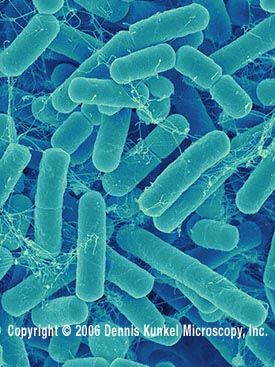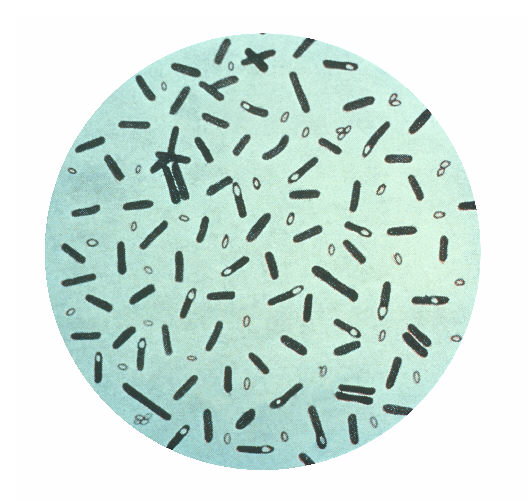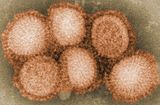



 Por Lobo LA, Jenkins AL, Jeffrey Smith C, Rocha ER.
Por Lobo LA, Jenkins AL, Jeffrey Smith C, Rocha ER.
Bacteroides fragilis é o patógeno oportunista isolado com maior frequência de infecções anaeróbicas. Há, entretanto, uma escassez de informações sobre os aspectos genéticos e moleculares da expressão gênica de seus fatores de virulência nas infecções intestinais. Um potencial mecanismo de virulência esta relacionado com a capacidade do B fragilis produzir hemolisinas.
Os resultados deste trabalho sugerem que as hemolisinas do B. fragilis são induzidas e reguladas diferencialmente in vivo. A estirpes parental e a mutante- hlyBA- atingiram níveis de aproximadamente 3–8 X 109 cfu/mL 1 dia após a infecção. No entanto, a estirpe mutante- hlyBA, após 8 dias de infecção diminuiu o número de células viáveis. Este é o primeiro estudo mostrando que a hemolisina HlyBA é um fator de virulência que desempenha um papel sobrevivência do na B. fragilis.
Expression of Bacteroides fragilis hemolysins in vivo and role of HlyBA in an intra-abdominal infection model
Lobo LA, Jenkins AL, Jeffrey Smith C, Rocha ER.
Department of Microbiology and Immunology, East Carolina University Brody School of Medicine, Greenville, North Carolina; Department of Medical Microbiology, Institute of Microbiology, Federal University of Rio de Janeiro, Rio de Janeiro, Brazil.
Abstract
Bacteroides fragilis is the most frequent opportunistic pathogen isolated from anaerobic infections. However, there is a paucity of information regarding the genetic and molecular aspects of gene expression of its virulence factors during extra-intestinal infections.
A potential virulence factor that has received little attention is the ability of B. fragilis to produce hemolysins. In this study, an implanted perforated table tennis "ping-pong" ball was used as an intra-abdominal artificial abscess model in the rat. This procedure provided sufficient infected exudate for gene expression studies in vivo. Real-time reverse transcription polymerase chain reaction (RT-PCR) was used to quantify the relative expression of hlyA, hlyB, hlyC, hlyD, hlyE, hlyF, hlyG, and hlyIII mRNAs. The hlyA mRNA was induced approximately sixfold after 4 days postinfection compared with the mRNA levels in the inoculum culture prior to infection. The hlyB mRNA increased approximately sixfold after 4 days and 12-fold after 8 days postinfection. Expression of hlyC mRNA increased sixfold after 1 day, 45-fold after 4 days, and 16-fold after 8 days postinfection, respectively. The hlyD and hlyE mRNAs were induced approximately 40-fold and 30-fold, respectively, after 4-days postinfection. The hlyF expression increased approximately threefold after 4-days postinfection. hlyG was induced approximately fivefold after 4 and 8 days postinfection. The hlyIII mRNA levels had a steady increase of approximately four-, eight-, and 12-fold following 1, 4, and 8 days postinfection, respectively. These findings suggest that B. fragilis hemolysins are induced and differentially regulated in vivo. Both parent and hlyBA mutant strains reached levels of approximately 3-8 × 10(9) cfu/mL after 1 day postinfection. However, the hlyBA mutant strain lost 2 logs in viable cell counts compared with the parent strain after 8 days postinfection. This is the first study showing HlyBA is a virulence factor which plays a role in B. fragilis survival in an intra-abdominal abscess model.
Referência:
 Por Caio T. C. C. Rachid, Adriana L. Santos,Marisa C. Piccolo,Fabiano C. Balieiro,Heitor L. C. Coutinho,Raquel S. Peixoto,James M. Tiedje, e Alexandre S. Rosado
Por Caio T. C. C. Rachid, Adriana L. Santos,Marisa C. Piccolo,Fabiano C. Balieiro,Heitor L. C. Coutinho,Raquel S. Peixoto,James M. Tiedje, e Alexandre S. Rosado
O cerrado brasileiro é um dos mais importantes reservatórios da biodiversidade do mundo. O cultivo da cana de açúcar está se expandindo neste bioma e estudos de como esta atividade agricola pode afetar as propriedades do solo e as comunidades nativas de bactérias do Cerrado são necessários. Neste estudo foi detectada uma redução da população bacteriana nos solos agrícolas quando comparado com as populações nativas do solo de cerrado. O cultivo de cana de açúcar levou a mudanças significativas na comunidade bacteriana, sendo que o filo Firmicutes e as Acidobacteria foram os grupos mais afetados.
Effect of Sugarcane Burning or Green Harvest Methods on the Brazilian Cerrado Soil Bacterial Community Structure
Caio T. C. C. Rachid, Adriana L. Santos,Marisa C. Piccolo,Fabiano C. Balieiro,Heitor L. C. Coutinho,Raquel S. Peixoto,James M. Tiedje, e Alexandre S. Rosado
1.Institute of Microbiology Paulo de Góes, Federal University of Rio de Janeiro, Rio de Janeiro, Rio de Janeiro, Brazil
2.Center for Nuclear Energy in Agriculture, Universidade de São Paulo, Piracicaba, São Paulo, Brazil,
3.Embrapa Solos, Rua Jardim Botânico, Rio de Janeiro, Rio de Janeiro, Brazil
The Brazilian Cerrado is one of the most important biodiversity reservoirs in the world. The sugarcane cultivation is expanding in this biome and necessitates the study of how it may impact the soil properties of the Cerrado. There is a lack of information especially about the impacts of different sugarcane management on the native bacterial communities of Cerrado soil. Therefore, our objective was to evaluate and compare the soil bacterial community structure of the Cerrado vegetation with two sugarcane systems.
Methods
We evaluated samples under native vegetation and the impact of the two most commonly used management strategies for sugarcane cultivation (burnt cane and green cane) on this diversity using pyrosequencing and quantitative PCR of the rrs gene (16S rRNA).
Results and Conclusions
Nineteen different phyla were identified, with Acidobacteria (≈35%), Proteobacteria (≈24%) and Actinobacteria (≈21%) being the most abundant. Many of the sequences were represented by few operational taxonomic units (OTUs, 3% of dissimilarity), which were found in all treatments. In contrast, there were very strong patterns of local selection, with many OTUs occurring only in one sample. Our results reveal a complex bacterial diversity, with a large fraction of microorganisms not yet described, reinforcing the importance of this biome. As possible sign of threat, the qPCR detected a reduction of the bacterial population in agricultural soils compared with native Cerrado soil communities. We conclude that sugarcane cultivation promoted significant structural changes in the soil bacterial community, with Firmicutes phylum and Acidobacteria classes being the groups most affected.
Referencia: Rachid CTCC, Santos AL, Piccolo MC, Balieiro FC, Coutinho HLC, et al. (2013) Effect of Sugarcane Burning or Green Harvest Methods on the Brazilian Cerrado Soil Bacterial Community Structure. PLoS ONE 8(3): e59342. doi:10.1371/journal.pone.0059342
1 Departamento de Medicamentos-Faculdade de Farmácia, Universidade Federal do Rio de Janeiro – UFRJ, Rio de Janeiro, Brazil
2 Instituto de Microbiologia Professor Paulo de Góes, Universidade Federal do Rio de Janeiro – UFRJ, Rio de Janeiro, Brazil
3 Instituto de Ciências Biomédicas, Universidade Federal do Rio de Janeiro – UFRJ, Rio de, Janeiro, Brazil
4 Departamento de Fármacos-Faculdade de Farmácia, Universidade Federal do Rio de Janeiro – UFRJ, Rio de Janeiro, Brazil
 O bioterápico denominado Influenzinum RC, foi preparado através da ultradiluição (diluição homeopática 30dH) do vírus Influenza A (A/Aichi/2/68 H3N20). As alterações celulares induzidas por este bioterápico foram analisadas através de analises bioquímicas e microscopia óptica e eletrônica.
O bioterápico denominado Influenzinum RC, foi preparado através da ultradiluição (diluição homeopática 30dH) do vírus Influenza A (A/Aichi/2/68 H3N20). As alterações celulares induzidas por este bioterápico foram analisadas através de analises bioquímicas e microscopia óptica e eletrônica.
O Influenzinum RC não causou efeito citotóxico nem alterações morfológicas em célula MDCK (Madin–Darby canine kidney) Apos 30 dias foi observado um aumento na taxa de mitose. A atividade mitocondrial foi alterada após tratamento com 10 e 30 dias. Ocorreu diminuição de PFK-1 e em células de macrófagos J774.48 tratadas a citocina TNF-α aumentou nos sobrenadantes das culturas de macrófagos.
H3N2 homeopathic influenza virus solution modifies cellular and biochemical aspects of MDCK and J774G8 cell lines
Objectives
To develop a biotherapy prepared from the infectious influenza A virus (A/Aichi/2/68 H3N2) and to verify its in vitro response.
Methods
The ultradiluted influenza virus solution was prepared in the homeopathic dilution 30dH, it was termed Influenzinum RC. The cellular alterations induced by this preparation were analyzed by optical and electron microscopy, MTT and neutral red assays. Glycolytic metabolism (PFK-1) was studied by spectrophotometric assay. Additionally, the production of tumor necrosis factor-α (TNF-α) by J774.G8 macrophage cells was quantified by ELISA before and after infection with H3N2 influenza virus and treatment
Results
Influenzinum RC did not cause cytotoxic effects but induced morphological alterations in Madin–Darby canine kidney (MDCK) cells. After 30 days, a significant increase (p < 0.05) in mitosis rate was detected compared to control. MDCK mitochondrial activity was changed after treatment for 10 and 30 days. Treatment significantly diminished (p < 0.05) PFK-1 activity. TNF-α in biotherapy-stimulated J774.G8 macrophages indicated a significant (p < 0.05) increase in this cytokine when the cell supernatant was analyzed.
Conclusion
Referencia: Homeopathy 2013; 102(1);31-40
